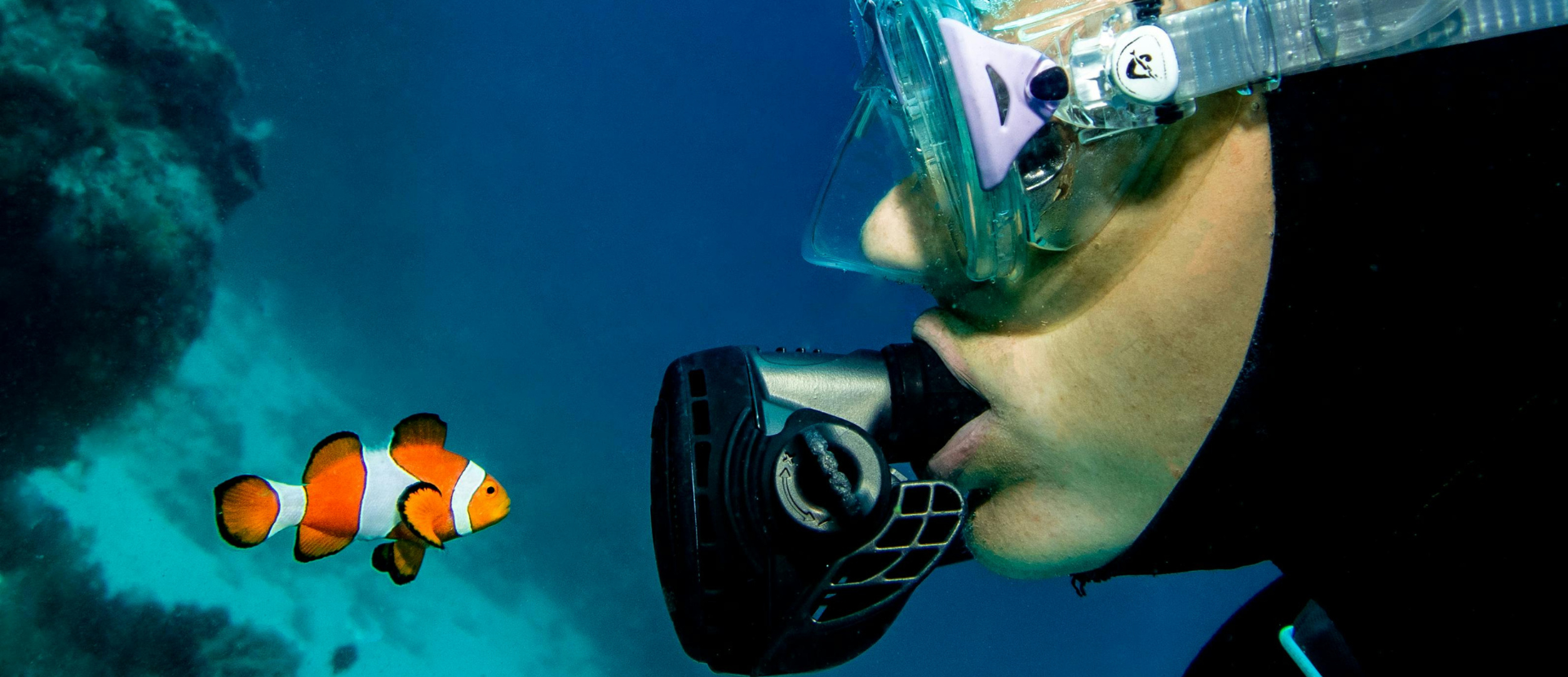- Marine Life Facts
- Science: Explained
What deep-sea creature is the best Halloween costume?
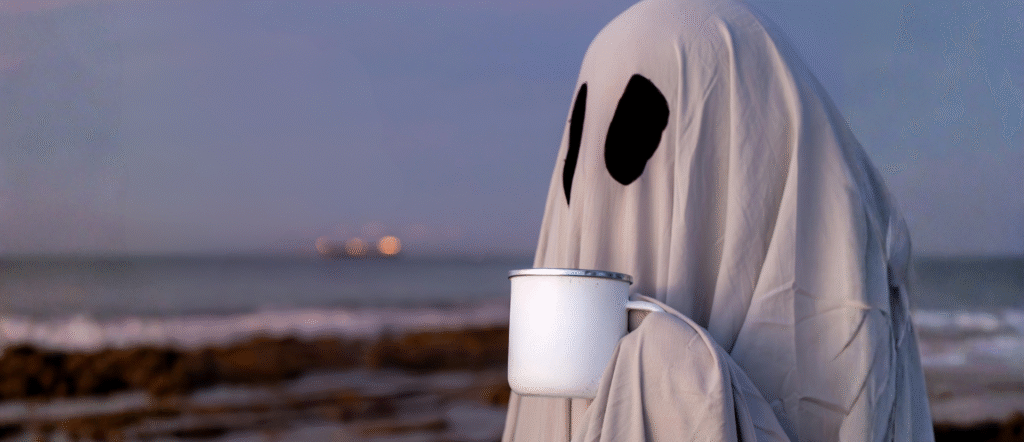
Trying to avoid spending money on a new Halloween costume you’ll only wear once?
Trying to be environmentally friendly? Just got a last-minute invite to an Ocean-themed costume party? Just love the deep sea? We got you. These deep-sea creature costumes should help you bring the Ocean to the Halloween party.
For the main event: dress up as an anglerfish
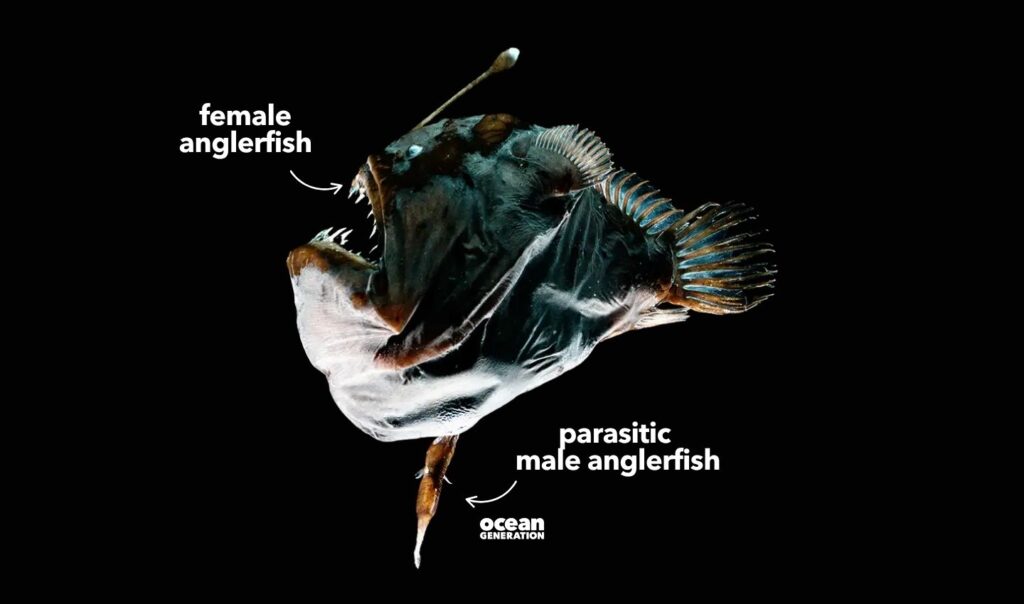
A classic. Anglerfish are the posterchild for the deep sea. Who hasn’t dreamt of these creatures lurking in the depths, with huge teeth and a glowing orb of light to draw you in until it is too late to escape.
Finding Nemo put this fish on the map for many of us (but it wasn’t completely accurate – see here).
We are using anglerfish liberally here: there are many different animals that could be referred to as anglerfish, but we are talking about deep-sea species from the Ceratioidei family.
The name means horn bearers, referring to the modified dorsal spine that for many species has a lit up lure at the end. Anglerfish host bacteria in their lure to generate light. This attracts fish, shrimp or squid close enough for the anglerfish to suck into its mouth, which is very big for their body.
Eyes too big for their stomach? Not likely for the anglerfish. They have extendable stomachs that can hold fish twice their size (useful if you aren’t sure when your next meal will swim along).
The main point to hit in your costume is the lure – the esca. Face paint for some big teeth would certainly add to the look.
What you need for the anglerfish Halloween costume:
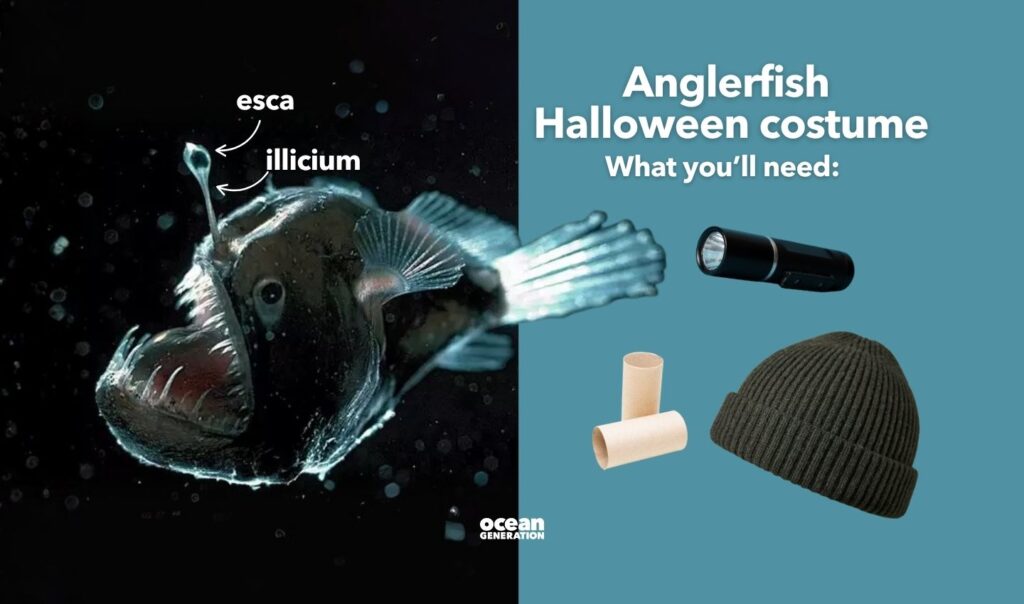
- Light source (headtorch, LED lights etc.)
- Something to hang it off
- Hat
- Black clothes
I have done this outfit before on very little notice, using toilet rolls as the illicium (the modified dorsal spine tipped by the esca). Other good options are repurposed clothes hangers or just a good-sized stick from outside. Attach your esca to your illicium (some glue, blue tac or tape), attach your illicium to your hat and away you go!
A battery pack on the back of the hat can act as a good counterweight to your lure.
Now just watch your work entrance everyone around you, tempting them closer. Too close, and they risk your teeth.
Optional extra: Add a parasitic male!
We aren’t telling you to invite your ex. But Anglerfish live in the deep Ocean, so when they get the chance for romance, they don’t let it pass.
The female anglerfish is far bigger than the male, who is little more than a sperm donor with a good sense of smell.
This size difference is most on show in Kroyer’s deep-sea anglerfish, Ceratias holboelli. Males can reach up to 1.3cm (while free-swimming), while the females are on average 77cm long.
When he finds a female, he bites her and doesn’t let go. Over time, he fuses with her, receiving nourishment in exchange for sperm. One female can have multiple males attached, and she can lay her eggs at her own leisure.
To add your parasitic male, just stick an empty loo roll in a sock and staple/attach it to yourself. The more the merrier!
For the witty one-liner: the cookiecutter shark
This is a true Halloween shark, with the old nickname “demon whale-biters”.
These little sharks gouge a circle of flesh out of animals, leaving bite marks as if cut out by a cookie cutter.
Whales and dolphins are often spotted with the strange circular wounds, multiple if they were unfortunate enough to come across a group of cookiecutters. One sei whale was found with 138 “cookies” cut out. Fortunately, these bitey biscuit bois are only half a metre long, so the damage they cause is limited.
The cookiecutter doesn’t need the dentist – rather than brushing their teeth, they lose the entire bottom row and usually swallow it with whatever meal they are enjoying (recycle some of the calcium).
What you need for the shark costume
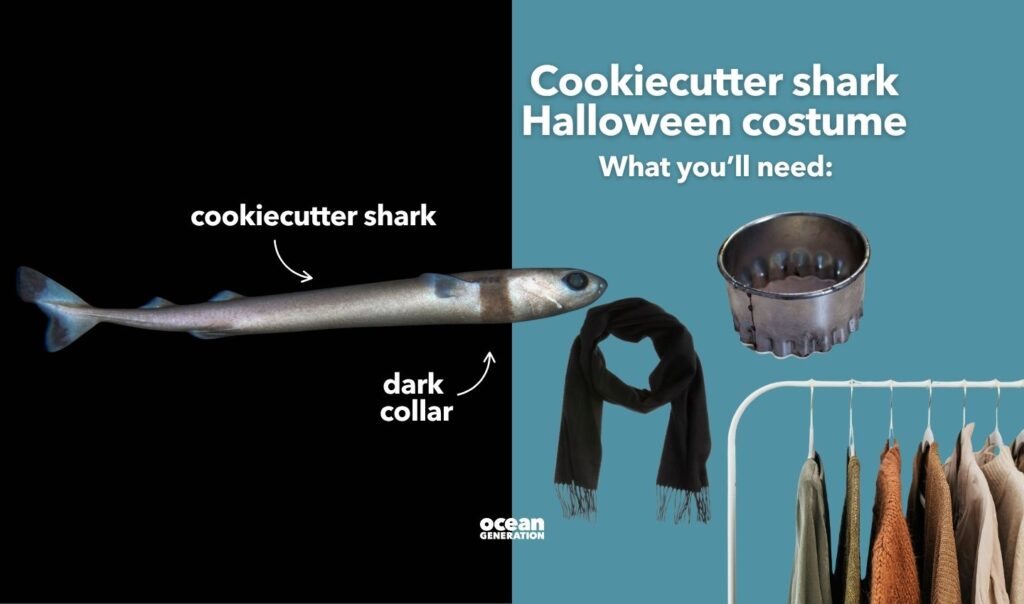
- A cookie cutter
- Cardboard/card
- A black scarf
- Brown clothes
- Optional: Chef hat
Sometimes simplicity is the way. Wear brown clothes, hang a cookiecutter around your neck and fashion a shark fin to attach somewhere, with the cardboard.
Add the black scarf around the neck, for the cookiecutters dark collar (this is one of the reasons they are also known as ‘cigar sharks’). If you want to make it a couple’s costume, dress your partner as a whale with some bloody circles on them!
Optional extra: glowing belly!
Cookie cutters have photophores on their belly, to camouflage them from predators and prey by matching the little light that penetrates the depths.
Why not add some flair to the costume? Add some glitter to the belly, or even better some glow in the dark stickers/paint or some fairy lights.
N.B. Cookie cutters do not have a classic shark’s dorsal fin, only a small one towards the tail. The recommendation is for costume purposes only. Also, don’t take any flesh out of your partner for this costume.
For the flamboyant and fiery: the Pompeii worm
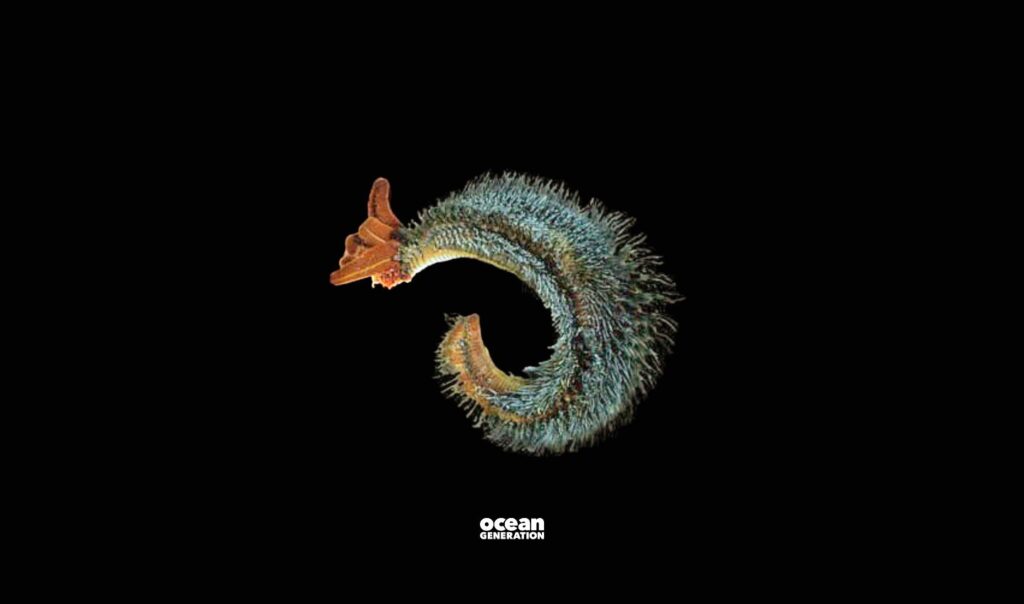
In the depths of the Ocean, there are huge chimneys belching out black and white smoke. Hydrothermal vents are where the Ocean meets the hot inside of our planet. Think of thermal spas with the heat turned way up. Combine the extreme heat with the crushing pressures and cold of the deep sea, it doesn’t sound like an appealing neighbourhood.
But they host rich ecosystems, full of incredible creatures adapted to these extremes. Hydrothermal vents may have been the origin of life on our planet.
The Pompeii worm shows a flamboyant distain for the usual limitations for life. Bright red, building a tube for itself to live in, it dances in water that would kill most. It can take the heat up to 55 degrees Celsius (131 Fahrenheit). But a woolly jumper of bacteria helps it stay cool, despite living in waters that can be over 100 degrees C (212 F). This is no normal jacket, as the worm has to keep it well fed with mucus in a symbiotic relationship*.
Four long, red-orange tentacles crown its head, used for breathing. Pompeii worms have the highest specific gill surface area of any marine worm and have acidic blood to encourage the oxygen to dissociate from their blood cells in their extreme environment. What other animal can work a feather boa with acid blood?
What you need for the costume
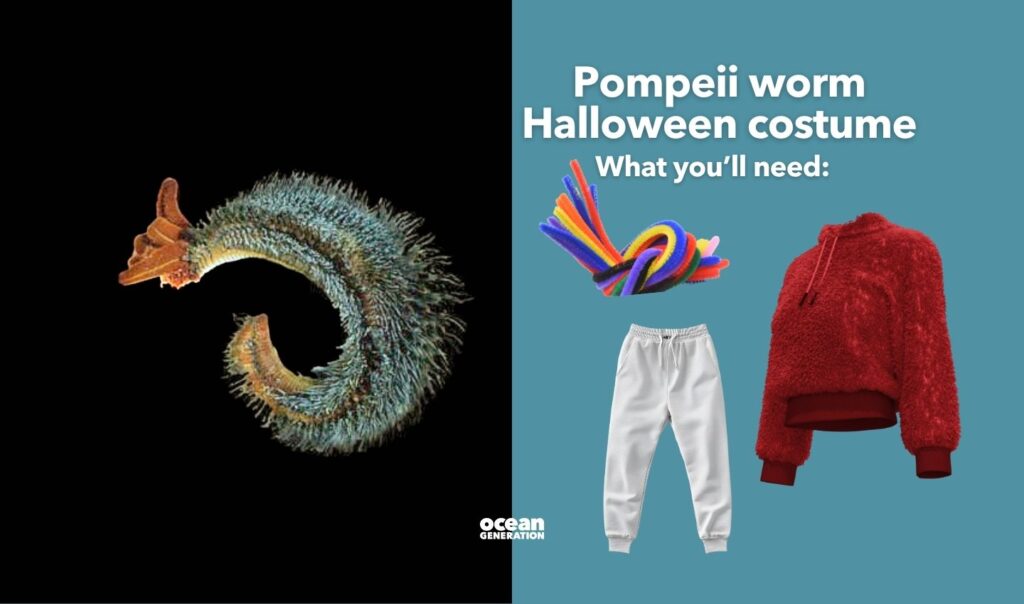
- Grey/white/black trousers or skirt
- Red/white long sleeve top – preferably fuzzy
- Red/pink/orange pipe cleaners/paper/feather boa
Be bold. Channel your inner Pompeii worm and dance in and out of your sulfur-and-protein based tube. A fluffy or fuzzy top will show off your bacterial biofilm and use some pipe cleaners or paper to make some tentacles around your head. Smaller feeding tentacles to add a bit extra.
For the dancers: Hoff or yeti crab Halloween costume
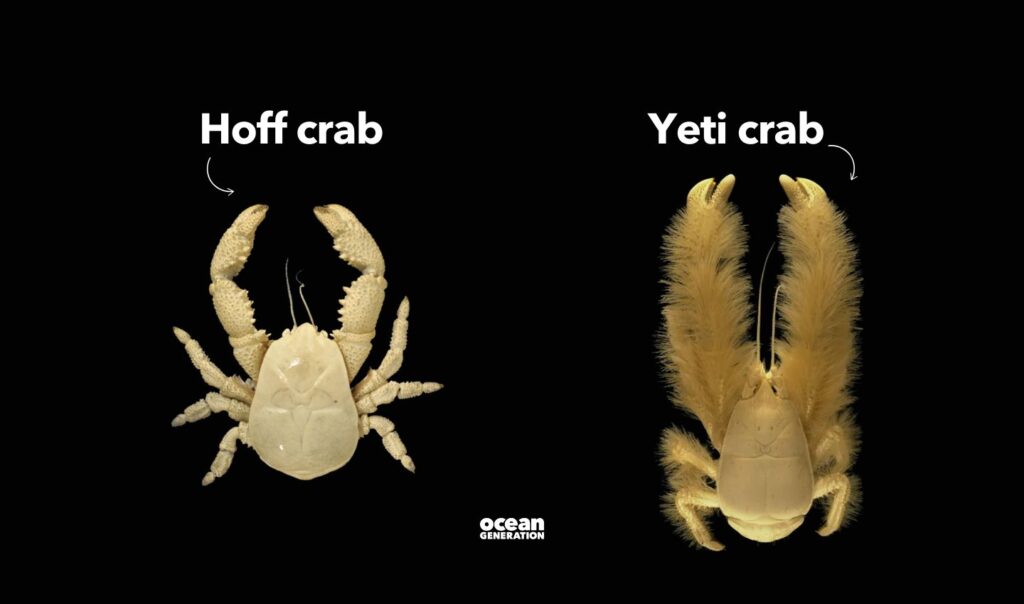
Another resident of the hydrothermal vents are crabs. There are two we want to spotlight. The Hoff and Yeti crabs.
Both are named after their appearance. One has a hairy chest and so bears the name of Baywatch legend David Hasslehoff. The yeti crab is the more general term for the Kiwa genus, of which the Hoff crab is a member.
These downy decapods are covered hairs. What is the other key to their success in the deep? Dancing.
The crabs wiggle and wave, which moves water over the hairs, feeding the colonies of bacteria that live there. These crabs grow their own food in their fur, so the fuzzier the better.
What you need for the crab costume
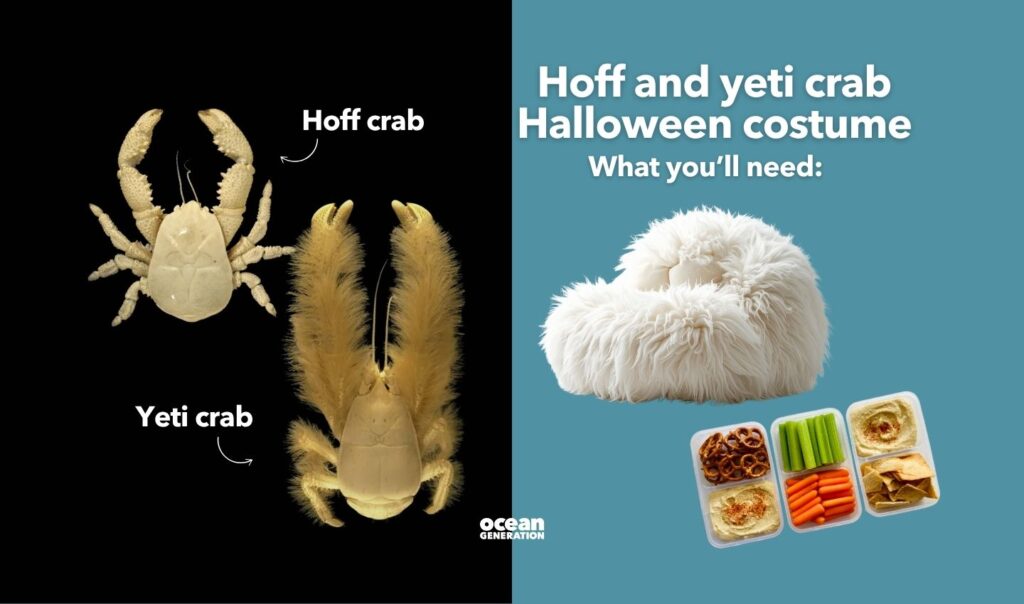
- Fuzz – for the Hoff, a hairy chest, and for a Yeti crab, get your arms fuzzy
- Creative claws
- Snacks in a pocket
The key for the crabs is owning your hair and rewarding your dancing. Every wiggle is a snack earner. Get fuzzy, and for added authenticity get some snacks in the fuzz for easy snacking.
For the dramatic introvert: the vampire squid
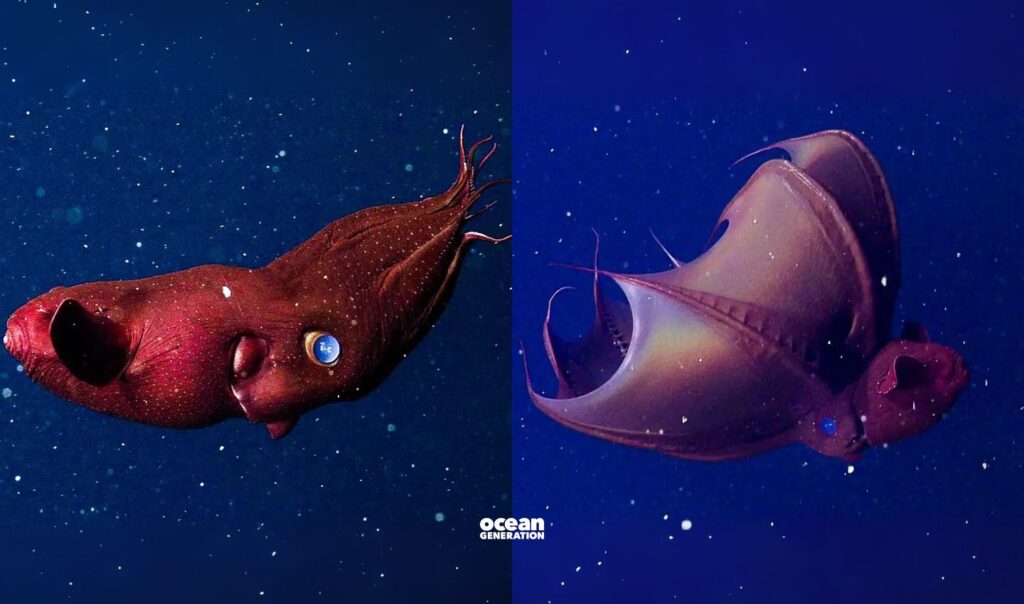
As another unfairly named creature, the Latin name of the vampire squid, Vampyroteuthis infernalis, literally means vampire squid from hell.
Red eyes, black or red colouration, and spikes lining their arms (incorrectly known as tentacles), living in the abyssal depths of the Ocean. You can see what they were going for.
Truly a survivor, these cephalopods live between 600m and 900m and can thrive where others can’t – oxygen minimum zones. These parts of the Ocean don’t have enough oxygen for most organisms to breathe. The vampire squid can survive where oxygen saturation is as low as 3% (the usual oxygen saturation in air is 21%).
If something does dare to get in their personal space, the vampire squid has a lesson for all of us: when stressed, be a pineapple.
The vampire squid will ‘invert’ itself, pulling its arms over its head, covering its photophores and revealing the spiny projections (known as cirri) underneath.
The glowing tips of its arms are held far above the head to draw attacks away from where they could do serious damage. The arm tips can grow back, so can be a handy (if you’ll pardon the pun) distraction.
What you need for the squid costume
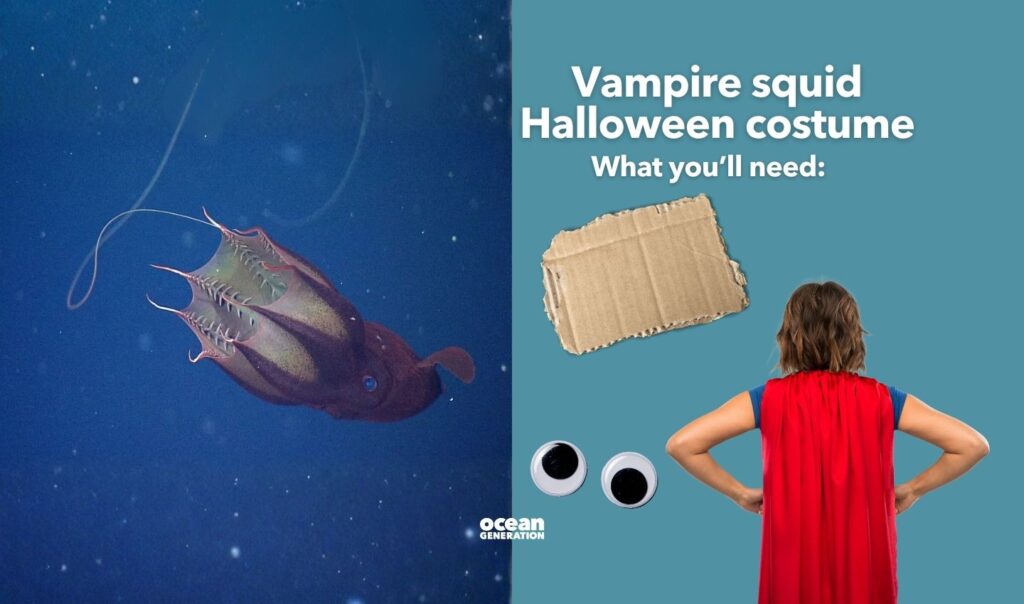
- Loose black or red clothing, ideally a cape
- Cardboard to make some spines
- Lights/sparkles
- Fins on the side of the head
- Red eyes
To embody the vampire squid, you need your own space. Space to let your cloak free. Line the inside with your cirri (the spines), in case of encroachment by unwanted parties. Coloured contacts or red eye makeup to give that squid from hell look.
Have fun with your lights on this one – vampire squid can control their own light show. Lights over the cloak and in your hands can make an entrancing look, ready to be muffled and switched to a spiny dark outer should the mood change.
Optional extra: Glitter juice
If the pineapple pose doesn’t work, a vampire squid has a secret weapon. A sticky cloud of bioluminescent mucus, which they can squirt at offending parties. This glowing goo can dazzle while the vampire squid escapes or stick to the transgressor and light them up for up to 10 minutes. Ten minutes is a long time to wait to see what else can see you in the dark Ocean.
A spray bottle, with some (eco-friendly) glitter mixed with water will give you your last line of defence.
*Grime, J. P., & Pierce, S. (2012). The evolutionary strategies that shape ecosystems. Wiley-Blackwell.


